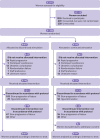Continued versus discontinued oxytocin stimulation in the active phase of labour (CONDISOX): double blind randomised controlled trial
- PMID: 33853878
- PMCID: PMC8044921
- DOI: 10.1136/bmj.n716
Continued versus discontinued oxytocin stimulation in the active phase of labour (CONDISOX): double blind randomised controlled trial
Erratum in
-
Continued versus discontinued oxytocin stimulation in the active phase of labour (CONDISOX): double blind randomised controlled trial.BMJ. 2021 May 17;373:n1242. doi: 10.1136/bmj.n1242. BMJ. 2021. PMID: 34001514 Free PMC article. No abstract available.
Abstract
Objective: To determine whether discontinuing oxytocin stimulation in the active phase of induced labour is associated with lower caesarean section rates.
Design: International multicentre, double blind, randomised controlled trial.
Setting: Nine hospitals in Denmark and one in the Netherlands between 8 April 2016 and 30 June 2020.
Participants: 1200 women stimulated with intravenous oxytocin infusion during the latent phase of induced labour.
Intervention: Women were randomly assigned to have their oxytocin stimulation discontinued or continued in the active phase of labour.
Main outcome measure: Delivery by caesarean section.
Results: A total of 607 women were assigned to discontinuation and 593 to continuation of the oxytocin infusion. The rates of caesarean section were 16.6% (n=101) in the discontinued group and 14.2% (n=84) in the continued group (relative risk 1.17, 95% confidence interval 0.90 to 1.53). In 94 parous women with no previous caesarean section, the caesarean section rate was 7.5% (11/147) in the discontinued group and 0.6% (1/155)in the continued group (relative risk 11.6, 1.15 to 88.7). Discontinuation was associated with longer duration of labour (median from randomisation to delivery 282 v 201 min; P<0.001), a reduced risk of hyperstimulation (20/546 (3.7%) v 70/541 (12.9%); P<0.001), and a reduced risk of fetal heart rate abnormalities (153/548 (27.9%) v 219/537 (40.8%); P<0.001) but rates of other adverse maternal and neonatal outcomes were similar between groups.
Conclusions: In a setting where monitoring of the fetal condition and the uterine contractions can be guaranteed, routine discontinuation of oxytocin stimulation may lead to a small increase in caesarean section rate but a significantly reduced risk of uterine hyperstimulation and abnormal fetal heart rate patterns.
Trial registration: ClinicalTrials.gov NCT02553226.
© Author(s) (or their employer(s)) 2019. Re-use permitted under CC BY-NC. No commercial re-use. See rights and permissions. Published by BMJ.
Conflict of interest statement
Competing interests: All authors have completed the ICMJE uniform disclosure form at www.icmje.org/coi_disclosure.pdf and declare: support for the submitted work as detailed above; no financial relationships with any organisations that might have an interest in the submitted work in the previous three years; no other relationships or activities that could appear to have influenced the submitted work.
References
-
- Martin JA, Hamilton BE, Osterman MJK, Driscoll AK. Births: Final Data for 2018. Natl Vital Stat Rep 2019;68:1-47. - PubMed
-
- World Health Organization. WHO recommendations: Induction of labour at or beyond term. 2018. https://www.ncbi.nlm.nih.gov/pubmed/30629393. - PubMed
-
- Simpson KR, Knox GE. Oxytocin as a high-alert medication: implications for perinatal patient safety. MCN Am J Matern Child Nurs 2009;34:8-15, quiz 16-7. 10.1097/01.NMC.0000343859.62828.ee - DOI - PubMed
Publication types
MeSH terms
Substances
Associated data
LinkOut - more resources
Full Text Sources
Other Literature Sources
Medical
Miscellaneous


